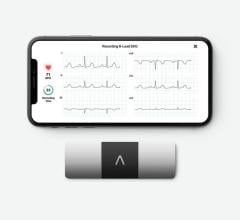January 22, 2013 — Peri-natal systems real-time clinical decision support company PeriGen Inc. announced the results of an independent validation study on fetal ECG strip interpretation favorably comparing PeriGen PeriCALM Patterns software with the findings of three experts from the National Institute of Health (NIH). The U.S. Food and Drug Administration (FDA)-cleared fetal strip interpretation technology is a component of the company's perinatal central surveillance offering.
The study reviewed the analysis of PeriCALM Patterns during the final hour of 100 tracings, and concluded that, "computerized fetal heart rate interpretation has substantial agreement with experts' evaluation. The software can be used to efficiently evaluate stored fetal heart rate data retrospectively as well as to screen in real time when an expert is not continuously evaluating the fetal heart rate," as reported by Steven Wiener of the Eunice Kennedy Shriver National Institute of Child Health and Human Development, Maternal-Fetal Medicine Units Network, Bethesda, Md. In over 97 percent of the assessments, the experts agreed with the analysis by PeriCALM Patterns.
This validation study is the first phase of a research collaboration announced earlier in 2012, Computerized Interpretation of Intrapartum FHR and Prediction of Neonatal Outcomes, with primary investigators George R. Saade, M.D., University of Texas Medical Branch in Galveston, Texas, and Sean Blackwell, M.D., University of Texas at Houston-Children's Memorial Hermann Hospital. The findings will be presented at the Annual Clinical Meeting of the Society of Maternal Fetal Medicine (SMFM) in San Francisco on Feb. 16, 2013 and were published in the American Journal of Obstetrics and Gynecology, Vol. 208, Issue 1, Supplement S316-S317.
"We are delighted by the results," commented Emily Hamilton, senior vice president of Clinical Research, PeriGen. "Internationally recognized experts participated in this extensive and completely independent test. These results demonstrate that clinicians can have confidence in the use of PeriCALM at the bedside. In addition, other researchers can rely upon the software to consistently analyze thousands of tracings retrospectively and test new scientific hypotheses to clarify what combination of FHR features are truly indicative of impending birth related hypoxic injury."
"PeriCALM Patterns from PeriGen provides far more clinical insight than other central perinatal surveillance systems into what is arguably the most subjective and highest risk task in delivering a baby — interpreting the fetal monitoring strip," said PeriGen CEO Matthew Sappern. "The incremental insight provided by PeriCALM Patterns means better information for making clinical decisions and promoting improved outcomes."
For more information: www.nichd.nih.gov, www.smfm.org, www.PeriGen.com


 November 21, 2023
November 21, 2023 








